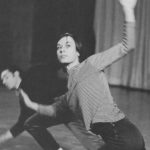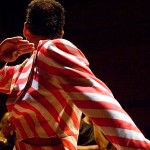DanceBoom!’s “African Threads” weaves a stunning tapestry of movement.
By Merilyn Jackson
For The Inquirer
Posted Feb. 2, 2009
If Africa is the origin of human life, it is also the origin of language, art, music and dance. As Philadelphia’s most renowned modern and Africanist dance writer and scholar, Brenda Dixon Gottschild, writes in her elegant DanceBoom! catalog essay, “African culture [and its] seeds pervade our daily lives from basketball to ballet and beyond Broadway.
“Africanisms are not a choice,” she writes, “but an imperative that comes to us the way electricity comes through wires.”
With a dozen dance groups, this year’s DanceBoom!, called “African Threads,” at the Wilma Theater offers a stunning array of Africanist-based dance works. There can be no stereotyping of Africanist dance. It is everything from traditional rite-of-passage dances to the celebration of hip-hop, Caribbean, jazz-inflected ballet, and cool tap.
“We looked at all the compass points of where our diaspora resides,” DanceBoom! curator Nick Stuccio said. “Koresh Dance Company is very interesting to us as they are rooted in jazz, but also [choreographer George] Balanchine was such a fan of African dance and first shocked ballet audiences when he introduced bent wrists and thrown-out pelvises like you’ll see in Agon.”
The key word to learn at this festival is polyrhythmic, a term that ties this festival together. The dancers and choreographers throw the word around as easily as they swish their hips while bobbing their shoulders to contrapuntal rhythms. (“The polyrhythmic dancing body may carry one rhythm in the feet plus one or more additional accent patterns in other body parts,” Gottschild writes.)
Audiences can sample from the festival’s following five groupings spread over different nights through Feb. 6.
Rennie Harris Puremovement
Rennie Harris Puremovement will start the festival off on its hip-hop head, hands and feet with a pastiche from the repertoire and add a premiere that Harris says “expresses the souls of inner-city African American and Latino communities.”
Lisanga Ya Bana Kin Philadanco or Odunde Kulu Mele African American Dance Ensemble Joan Myers Brown, America’s most formidable heroine of African American dance, will have her 35-year-old Philadelphia Dance Company (called Philadanco) perform the riveting trio from Alonzo King’s Steal Away, in which a woman dissolves into despair under the weight of slavery while her two male partners fail to save her.
Philadanco will perform only on Sunday and Tuesday, with Philadelphia’s Odunde appearing on Feb. 4 and 5 to teach audiences social dances of the ’40s, ’50s and ’60s.
Kulu Mele’s steely artistic director, Dorothy Wilkie, is North Philly-born and -reared, and melts into sweet smiles when the dance takes over her body. Her company will present three dances, including a solo called Amazon War Dance by guest artist Djian Tie from the Ivory Coast.
Congolese choreographer Mufulu Kingambo Gilonda, who has been living and working in Philadelphia for 15 years, will perform with his company, Lisanga Ya Bana Kin. They will perform Gizembe, about two regions in the Congo that “have to learn to get along.”
Koresh Dance Company Pennsylvania Ballet Merian Soto
Roni Koresh describes his Negative Spaces as a cabaret.
“It’s all urban jazz-influenced, almost done like a minstrel show, but all the dancers are in white face,” he said. “Once you put on a mask you can do whatever you want.”
George Balanchine made his 1957 masterpiece Agon with an awareness of the era’s racial tensions. He set a major male role on Arthur Mitchell, at the time the New York City Ballet’s only black dancer. Now Meredith Rainey, one of several black dancers in the Pennsylvania Ballet, profoundly inhabits the role he dances with principal ballerina Arantxa Ochoa.
Merian Soto changed her The Art of Improvisation program at the last minute, recycling a title from a show last year, What’s Heart Got to Do With It, a structured improvisation duet for dancer and musician.
Tania Isaac Paule Turner / court Charles Anderson / dance theatre x A phenomenal dancer from St. Lucia, Tania Isaac explores the “cultural schizophrenia” of living in a strange land.
“We jump-cut our lives every day,” Isaac said. “You become adept at shifting from one personality to the other, depending on who you interact with, and that is implicit in my work.”
For DanceBoom! she has streamlined an earlier work, home is where I am… .
In the belief that shock is the best route to awareness, Paule Turner presents the fourth and final section of Touched, the 25-minute “Hitting Bottom,” with his company of six dancing in the nude. Turner has been working with dramaturge and author Don Belton on this explosive multimedia show for more than a year. With the Ku Klux Klan and a beheading in the piece, Turner hopes to show that the world can survive such atrocities.
Charles Anderson is black and gay, and known for big works with magnificent male dancers. Here, however, the cast of Parables of Mutants and Madmen consists of 18 women, with live music.
“Being a member of a historically marginalized group, I’ve always identified with superheroes and their dual identities,” Anderson said.
Germaine Ingram Kariamu & Company Eleone Dance Theatre
DanceBoom! will often move you to tears, but nothing else can make you weep like Nina Simone’s songs. Germaine Ingram, Philly’s top tapper, has refitted three of them for her new show, Nina’s Laments. A jazz quartet interacts with the three women dancers, and Ingram shows segments of her ground-breaking video, Plenty Good Women Dancers: African American Hoofers From Philadelphia.
Kariamu Welsh’s company of seven astonishingly gifted dancers will perform the Jamaican-influenced Sankofa-Ja! and The Museum Piece, a work that harks back to when Sarah Baartman, the so-called Hottentot Venus, was displayed throughout Europe, and arcs through the American objectification of black peoples.
Eleone is a title made up from its founder’s name, the late E. Leon Evans. Its 13 finely tuned dancers will perform a lyrical work by codirector Shawn-Lamere Williams to Bobby McFerrin’s “Sweet as the Morning’s Flow,” innovative choreographer Christopher L. Huggins’ Highway, and The Movement by Wayne St. David.
“African Threads” includes a talk on “The Rise of the Tango” by Robert Farris Thompson, art historian and Yale professor, on Feb. 5 at 10:30 a.m. Odunde, a Philadelphia organization that promotes African culture, will give dancing lessons on Feb. 4 and 5. And a dance photography exhibit called “Roots and Threads” will run from Feb. 3 through April 17 at the Open Lens Gallery at the Gershman Y.




